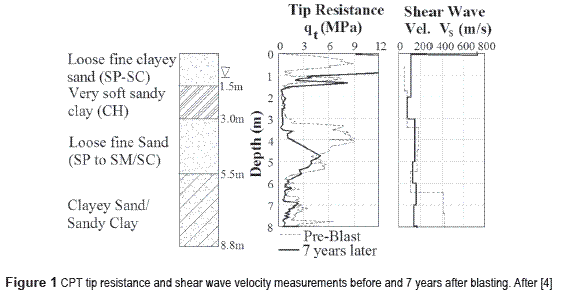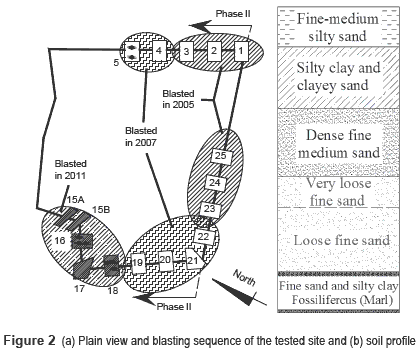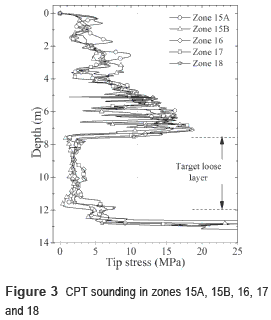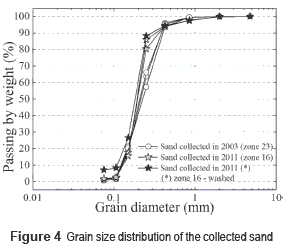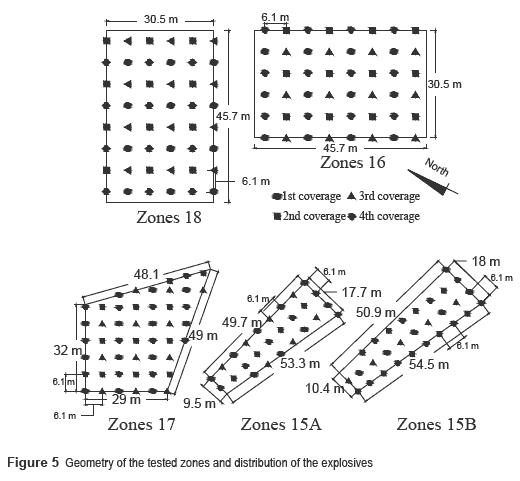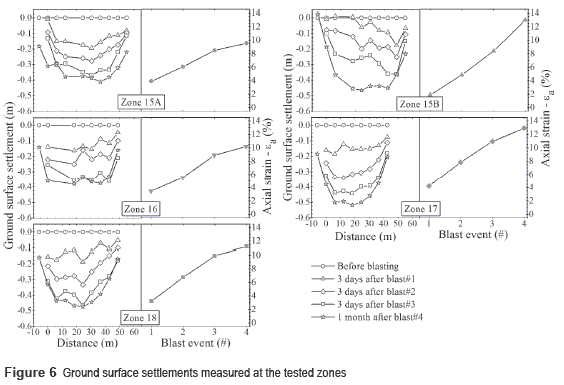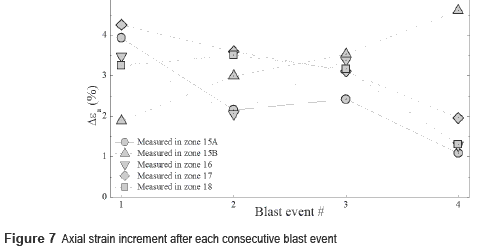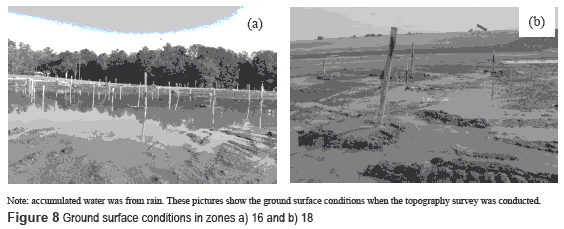Services on Demand
Journal
Article
Indicators
-
 Cited by SciELO
Cited by SciELO -
 Access statistics
Access statistics
Related links
-
 Cited by Google
Cited by Google -
 Similars in
SciELO
Similars in
SciELO -
 Similars in Google
Similars in Google
Share
Revista Facultad de Ingeniería Universidad de Antioquia
Print version ISSN 0120-6230
Rev.fac.ing.univ. Antioquia no.70 Medellín Jan./Mar. 2014
ARTÍCULO ORIGINAL
Ground surface settlement of loose sands densified with explosives
Asentamiento de la superficie del terreno de arenas sueltas densificadas con explosivos
Carlos A. Vega-Posada1, David G. Zapata-Medina1*, Edwin F. García Aristizabal1
1Facultad de Ingeniería, Universidad de Antioquia. Calle 67 No. 53-108. Medellín, Colombia.
2Dept. of Civil Engineering, National University of Colombia. Calle 59A No 63-20. Medellín, Colombia.
*Autor de correspondencia: teléfono: + 57 + 4 + 425 51 50, correo electrónico: dgzapata@unal.edu.co (D. Zapata)
(Recibido el 15 de agosto de 2013. Aceptado el 23 de enero de 2014)
Abstract
This paper presents the results of a blast densification program conducted at a sanitary landfill located in South Carolina, U.S., to densify a liquefiable loose sand layer deposit and thus increase its resistance to liquefaction and flow during a seismic event. Five zones were selected for improvement, and a total of four blasting passes were implemented at each zone. Additionally, pre- blast CPT soundings were performed to determine the location of the loose sand layer, and thus define the distribution of the explosives. Topographic surveys were conducted along the centerline of the long direction to measure the ground surface settlements before and after each blast event. Measurements of ground surface settlements indicated that, regardless of the initial ''apparent'' decrease in penetration resistance commonly measured by standard verification tests, blast densification is an effective technique to increase the soil density. At the tested zones, the final relative densities varied from 65% to 91%. At these densities, the improved sand layer is not considered susceptible to liquefaction and flow, and a dilative response will be expected during a seismic event.
Keywords: Blast densification, sands, gassy sands, field performance, settlements
Resumen
Este artículo presenta los resultados de un programa de densificación con explosivos que se realizó en un relleno sanitario localizado en el Sur de Carolina, Estados Unidos, para densificar un depósito de arena suelta altamente licuable, y así aumentar su resistencia a licuación y flujo en caso de un evento sísmico. Se seleccionaron cinco zonas para densificar, y se ejecutaron un total de cuatro detonaciones en cada una ellas. Adicionalmente, se realizaron ensayos de CPT antes de la primera detonación para determinar la localización de la capa de arena suelta, y así definir distribución de los explosivos. En cada una de las zonas se llevaron a cabo levantamientos topográficos, a lo largo de la línea central de la dirección larga, para medir los asentamientos de la superficie del terreno antes y después de cada detonación. Los asentamientos medidos mostraron que, independiente de la ''perdida'' inicial en resistencia a la penetración comúnmente medida por ensayos de campo, la densificación con explosivos es una técnica efectiva para densificar el suelo. En las zonas ensayadas, la densidad relativa final varió entre 65 % y 91 %. A estas densidades, la capa de arena mejorada no es considerada susceptible a licuación y flujo esperándose un comportamiento dilativo durante un evento sísmico.
Palabras clave: Densificación con explosivos, arenas, arenas gaseosas, desempeño de campo, asentamientos
Introduction
The effect of earthquakes on infrastructure facilities is an important topic of interest in geotechnical research and practice. In seismically active zones, earthquake engineering and seismic design considerations for highway and railroad embankment are essential. A key design issue for such facilities is whether or not liquefaction will occur during an earthquake. The consequences of this type of ground failure are usually severe, resulting in severe damage to a facility and in some cases the loss ofhuman life. One economical approach to minimize the effect of liquefaction on embankments that span a large area is to improve the engineering characteristics of the ground to withstand the expected earthquake by controlled blasting.
Blast densification offers several advantages when compared to other soil improvement techniques. It is an economic approach, with a relatively rapid construction process and without the need of heavy construction equipment allowing work on remote or difficult areas. The main limitation of this technique is that when common verification tests such as the Cone Penetration Test (CPT),
Standard Penetration Test (SPT) and Shear Wave Velocity Test (SWVT) are conducted, the results at times can be counterintuitive. Some of these test results indicate an initial, and in some cases a more lasting, decrease in strength and stiffness of the densified soil mass [1-3], and in some cases these values never return to levels above to the pre-blasting conditions [4-6].
This ''apparent'' lack of increase in penetration resistance suggests that the soil has not been improved even though the ground surface settles considerably. This result raises concerns regarding the future performance of the soil and casts doubts on whether or not the loose sands have really been improved to the point where liquefaction is not possible. As an example, figure 1 shows the CPT tip resistance and shear wave velocity measurements before and 7 years after blasting at a site located in Charleston, South Carolina, United States [4]. The results showed that the tip resistance and shear wave velocity after 7 years were lower than the pre- blasting levels at the ''improved'' layer, from 3.0 m to 5.5 m, even though a total ground surface settlement of 0.28 m was measured after three blasting passes.
This paper presents the results of a field blast densification program conducted at a sanitary landfill located in South Carolina, USA, to densified a potentially liquefiable loose sand layer and thus prevent its liquefaction and flow. A total of five zones were selected for this study. Cone penetration tests were conducted, at each zone, before blasting to determine the depth and thickness of the loose sandy layer. A total of four passes were implemented, and ground surface settlements were measured before and after each blast. The results show that the density of the blasted layer significantly increases, regardless of the penetration resistance values, meaning that blasting is a viable option to increase the liquefaction resistance of the loose sand.
Blast densification: procedure and practice
Blast densification has been used to densify loose, saturated, sandy soils for more than 80 years [7-11]. Although it is considered to be an economical approach when compared with other alternatives, it has not been widely accepted because the design is primarily based on experience rather than on theory [12].
Blast densification consists on drilling a borehole through the loose layer requiring treatment and then distributing the explosives throughout the entire layer. The explosives are detonated with multiples delays to generate a cyclic load and to minimize peak ground acceleration, while inducing cyclic stresses. The energy released by the explosives creates a high pressure shock wave that initially increases the normal stresses in the soil mass as the shock wave approaches and then decreases as the shock wave passes [13]. These cyclic stresses, combined with the large amount of gases produced and released during detonation, increase the pore fluid pressure, and as a consequence, the effective stresses are reduced until a zero effective stress state is reached in the soil. After liquefaction, the soil reconsolidates to a denser state, as the induced porewater pressure dissipates and the effective stresses return to the pre-blast values.
The amount of blast densification is believed to be greatly influenced by the charge weight, horizontal charge spacing, vertical separation between charges, charge depth, number of coverages, and firing sequence and timing [13]. Several empirical and semi-empirical guidelines have been proposed in the technical literature for a satisfactory blast densification design. A summary of these guidelines can be found in [5].
Field blasting program
A blast densification program was conducted in a landfill located in South Carolina to increase the density of a highly liquefiable loose sand layer deposit, located between nominal depths ranging from 7.5 m to 12 m throughout the site, and thus prevent its liquefaction and flow during an earthquake. Since 1998, GeoSyntec Consultants Inc. has been in charge of designing and evaluating the ground improvement at this site by conducting a set of control blast detonations on zones located along the perimeter of the targeted area.
Description of the site
As part of this ongoing field densification program, zones 15A, 15B, 16, 17 and 18 were tested in 2011. Figure 2 shows a plain view of the tested site, the soil profile and the time sequence of the blasting program. The soil profile at the site is generally composed of six distinctive layers, as shown in Figure 2b. Starting at the ground surface, the soil profile consists of (i) 1.0 m to 1.5 m fine- medium silty sand; (ii) 1.2 m to 3.0 m of silty clay and clayey sand; (iii) 3.0 m to 4.5 m of dense fine to medium sand; (iv) 0.3 m to 1.5 m of very loose fine sand; (v) 1.5 m to 4.5 m of loose fine sand; and (vi) more than 30 m of a fine sand and silty clay fossiliferous layer regionally known as Cooper Marl [14]. The water table is located between 0.8 - 1.5 m below the ground surface.
CPT soundings were performed in the tested zones before blasting to determine the penetration resistance of the loose sand layer and to estimate its depth and thickness. The results from these soundings are presented in Figure 3. In general, the top of the sand layer was encountered at depths ranging from 7.3 m to 7.9 m and its thickness varied from 3.5 m to 4.1 m. Only the portions of the sand deposited in a very loose to loose state, qc/Pa< 4 MPa [15], were considered to contribute to ground surface settlements after blasting.
Description of loose sand layer
The loose sand layer located at a depth from 7.5 m to 12 m was categorized, according to the USCS, as a poorly graded sand (SP). This sand is a light brown, clean, fine grained sand, very angular in shape, with little or no fines. Figure 4 shows the grain size distribution. As the figure shows, 100% of the material passed the sieve #4 and less than 1.5 % and 7% passed the sieve #200 when the dry and wet sieve analysis were conducted, respectively. The coefficients of uniformity, Cu, and curvature, Cr, were in average 1.72 and 1.06, respectively. The minimum and maximum void ratios were emin = 0.62 and emax = 1.05, respectively; and the specific gravity, Gs, was found to be 2.6, suggesting that the sand is quartz.
Blast configuration and distribution of explosives
Figure 5 shows the geometry of the tested zones and the aerial distribution of the explosives. As shown in Figure 2a, the perimeter was divided into approximately 25 zones (only 17 ofthese zones are shown), with most of the zones measuring 30.5 m × 45.7 m and separated a distance of 30.5 m along the perimeter alignment. The blast densification program consisted of installing explosives at the middle of the targeted loose sand layer (z = 10 m) and separated in a square grid pattern with a fixed spacing of 6.1 m. The explosive used was Hydromite 860 (powder factor of 40 grams / m3) and the individual explosive charge was 15.4 kg. A total of four blast coverages were implemented at each zone to achieve the desirable ground surface settlement. The time delay between blasting events was approximately 7 days.
Field testing results
Ground surface settlements
Standard topographic surveys were performed to measure the ground surface settlements, along the centerline of the long direction, before and after each blasting event. These settlements were used to compute the average total volume change that occurred during reconsolidation following the explosion, and hence to evaluate the effectiveness of the blast densification technique in improving the soil density and decreasing its susceptibility to liquefaction and flow. The total settlement measured at the ground surface is expected to occur within the blasted layer [5,16]. The topographic surveys were conducted 3 days after the first, second, and third blast event, respectively and 30 days after the fourth and last blast event. The excess pore water pressure generated by the shocking wave had dissipated by the time of the readings, and no more ground surface settlements are expected to occur [5].
Figure 6 shows the results of the ground surface settlements measured at zones 15A, 15B, 16, 17 and 18, before and after each blast event. The average ground surface settlement after the fourth blast event ranged from 0.36 m, in zone 16, to 0.51 m, in zone 17. These zones experienced a uniform settlement over a horizontal distance of about B= 40 m. Because B/t= 9 (t= initial thickness of loose sand layer) is much greater than 1.0, it would be correct to assume that the loose sandy layer undergoes a one-dimensional consolidation settlement in the vertical direction after blasting. In general, the maximum settlement occurs at the center of the site and the incremental surface settlements decrease after each consecutive blast.
The estimated initial in-situ void ratio for this sandy deposit ranged from e0≈0.97 (DR≈12 %), inferred from the CPT data to e0≈0.84 (DR≈ 24 %), computed from the natural water content measurements [6]. The final void ratio (ef), computed from these values and the above range of settlements, ranged from 0.66 to 0.77. These ef values correspond to relative densities varying from 65% to 91%. At these densities, a dilative response is expected and hence, after densification, the soil is not considered susceptible to liquefaction and flow during a seismic event.
Computed axial strains
In average, the accumulative axial strain experienced by the loose sand layer was 3.5%, 6%, 9% and 11.5% after the first, second, third, and fourth blast event, respectively (see Figure 6). The axial strain was computed as follows (1):

where εa is the induced axial strain by the blast, ΔH is the average surface settlement measured after the blast event; H is the average thickness of the targeted layer before the blast event.
Figure 7 shows the axial strain increment, Δεa, after each consecutive blast event. As a common trend, the axial strain increment decreased as the number of passes increased, indicating that the effectiveness of the blast densification technique is limited to a certain number of passes, and one more pass would not necessary be reflected in a significant axial strain.
The aforementioned trend seems to be consistent among the blasted zones except in zone 15B where a contrary trend was observed. Although no physical evidence (photos or videos) of the site condition after blast densification was available for this zone, this discrepancy could be a result of the difficulty to access the monitoring points to conduct the topographic survey after each blast event and/or a poorly executed topographic survey, as evidenced in other zones (For example, Figure 8). For instance, the soil deposited on the ground surface after each blast event was not properly removed at each measuring point before conducting the survey.
Conclusions
Blasting is an effective densification technique to increase the soil density, regardless of the initial ''apparent'' decrease in penetration resistance measured by common field verification tests. At the tested zones, the relative density increased from 12 - 24 % to 65 - 91%, where a dilative response is expected and the sand deposit is not considered susceptible to liquefaction and flow during a seismic event.
In general, the maximum settlement occurred at the center of the tested zones and the incremental surface settlements decreased after each consecutive blast. In average, the accumulative axial strain experienced by the loose sand layer was 3.5%, 6%, 9% and 11.5% after the first, second, third, and fourth blast event, respectively.
The incremental axial strain decreased as the number of passes increased, indicating that more passes would not necessary be reflected in more significant axial strains. For this case study, four passes were enough to achieve the desirable amount of settlements.
The blasted zones experienced a uniform settlement over a horizontal distance, B, of about 40 m, indicating that, after blasting, the loose sandy layer experienced a one-dimensional consolidation settlement in the vertical direction. Under this premise, a one-dimensional compression test (oedometer test) could provide a clear indication of the amount of volume change that will occur within the liquefied layer after each blast event. Laboratory work is currently underway under a joint effort of Northwestern University and Antioquia University to validate this hypothesis.
Acknowledgments
Research funding for the field work was provided by the Infrastructure Technology Institute (ITI) of Northwestern University and GeoSyntec Consultants. The support of Mr. Erik Miller, engineer at GeoSyntec Consultants and Richard Finno, professor at Northwestern University is greatly appreciated.
References
1. S. Ashford, K. Rollins, J. Lane. ''Blast-induced liquefaction for full-scale foundation testing.'' Journal of Geotechnical and Geoenvironmental Engineering. Vol. 130. 2004. pp. 798-806. [ Links ]
2. K. Rollins, J. Anderson. ''Cone penetration resistance variation with time after blast liquefaction testing.'' D. Zeng, M. Manzari, D. Hiltunen (editors). Geotechnical Earthquake Engineering and Soil Dynamics. Vol. IV GSP 181. Ed. ASCE Labrary. Sacramento, USA. 2008. pp 1-10. [ Links ]
3. Z. Solymar. ''Compaction of alluvial sands by deep blasting.'' Can. Geotech. J. Vol. 21. 1984. pp. 305-321. [ Links ]
4. W. Camp, P. Mayne, K. Rollins. 2008. ''Cone penetration testing before, during, and after blast-induced liquefaction.'' D. Zeng; M. Manzari, D. Hiltunen (editores). Geotechnical Earthquake Engineering and Soil Dynamics. Vol. IV, GSP 181. Ed. ASCE Labrary. Sacramento. USA. 2008. pp. 1-10. [ Links ]
5. A. Narsilio, J. Santamarina, T. Hebeler, R.Bachus. ''Blast Densification: Multi-Instrumented Case History.'' Journal of Geotechnical and Geoenvironmental Engineering. Vol. 135. 2009. pp. 723-734. [ Links ]
6. G. Thomann, D. Hryciw. 1992. ''Stiffness and strength changes in cohesionless soils due to disturbance.'' Can. Geotech. J. Vol. 29. pp. 853-861. [ Links ]
7. C. Hall. ''Compacting a dam foundation by blasting.'' J Soil Mech. and Found. Div. ASCE. Vol. 88. 1962. pp. 33-51. [ Links ]
8. U. La Fosse. Improvements by Deep Blasting: Marine Corps Reserve Training Center. Westover Air Reserve Base. Company Report, GeoDesign, Inc. Massachusetts, USA. 2002. pp.148. [ Links ]
9. V. Raju, G. Gudehus. Compaction of loose sand deposits using blasting. Proc. Proceedings, 13rd International Conference on soil mechanics and foundation engineering. New Delhi, India. 1994. pp. 1145-1150. [ Links ]
10. Z. Solymar, B. Iloabachie, R. Gupta, L. Williams. ''Earth foundation treatment at Jebba dam site.'' Journal of Geotechnical Engineering. Vol. 110. 1984. pp.1415-1430. [ Links ]
11. A. Wild. ''Tower foundations compacted with explosives.'' Electr. World. Vol. 66. 1961. pp. 36-38. [ Links ]
12. W. Gohl, M. Jefferies, J. Howie, D. Diggle. ''Explosive compaction: design, implementation and effectiveness.'' Geotechnique Vol. 506. 2000. pp. 57-665. [ Links ]
13. W. Narin Van Court, J. Mitchell. ''Soil improvement by blasting Part 1.'' Explosives Engineering. Vol. 12. 1994. pp. 34-41. [ Links ]
14. GeoSyntec Consultants Inc. Ground improvement results of optimized blast densification program. Oakridge Sanitary Landfill, Dorchester, SC, Final Report - Project Number GD3397. Prepared for USA Waste Services, Inc. Atlanta. USA. 2005. pp.75. [ Links ]
15. F. Kulhawy, P. Mayne. Manual on estimating soil properties for foundation design. Cornell University. Final report. New York, USA. 1990. pp. 291. [ Links ]
16. R. Bachus, T. Hebeler, J. Santamarina, M. Othman, G. Narsilio. Use of field instrumentation and monitoring to assess ground modification by blast densification. Proceedings, 15th Great Lakes Geotechnical/ Geoenviromental Conference, Applications of geotechnical instrumentation for performance evaluation of constructed facilities. Indianapolis, USA. 2008. pp. 15. [ Links ]













